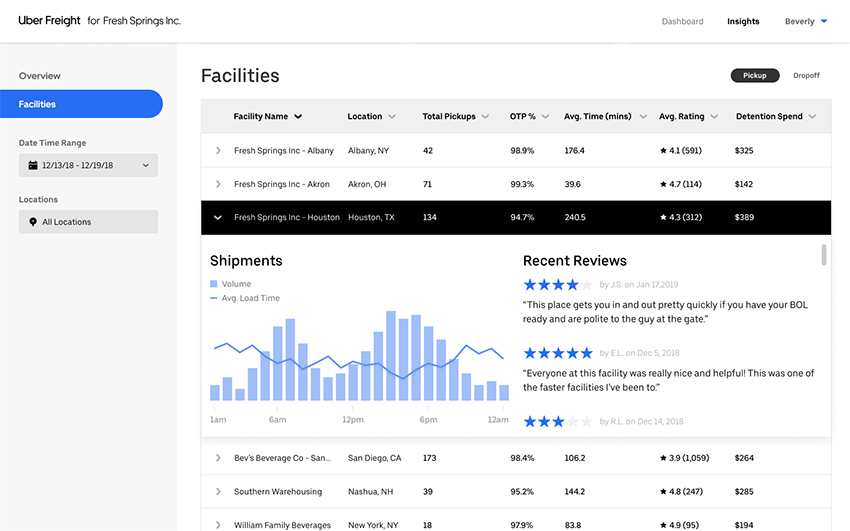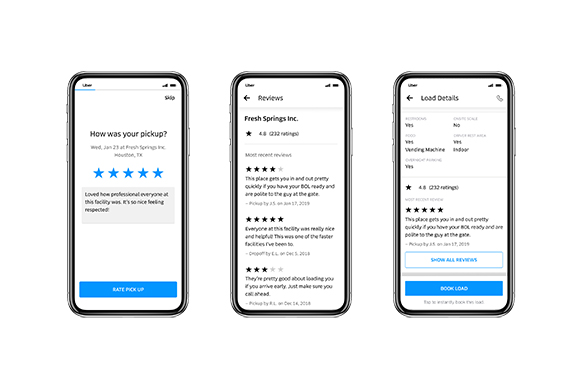Uber Freight introduces Facility Ratings to help carriers and shippers learn from each other
Uber Freight’s Kaufman said that the early feedback for Facility Ratings from shippers has been very positive, even if they see poor ratings.
Taking a cue from its corporate sibling, the ubiquitous, ride-sharing service Uber, Uber Freight, the company’s app that matches trucking companies with loads to haul, announced today it has introduced Facility Ratings to its portfolio.
In a blog posting, Uber Freight officials explained that when Uber introduced ratings as part of its rideshare platform, it had a transformative effect on transportation. And with the introduction of Facility Ratings for the Uber Freight app, it brings the same advantages but within a freight context, explaining that this new offering “empowers carriers and their drivers with the ability to share honest feedback about the facilities they visit,” and “also gives shippers the insights they need to make positive change and improve driver experiences.”
Taking that a step further, the blog posting noted that with truck drivers spending a lot of time at facilities to drop off and pick up freight and often spending the night after a full day of driving, facility-related factors such as detention time, bathroom access, and parking availability serve as barometers that will drive their choice to incentivize or discourage drivers from taking loads from a facility. It drove that point home, citing a 2018 survey from Zipline Logistics, which polled 150 carriers, that found 80% of carrier respondents declined to move loads from certain facilities for various reasons, including inflexible appointment hours and lengthy detention times, which are estimated to cost motor carriers between $1.1 billion to $1.3 billion in annual revenue, according to data from the U.S. Department of Transportation.
Xinfeng Le, carrier product lead, for Uber Freight, told LM that one of the key drivers for the introduction of Facility Ratings to the Uber Freight platform stemmed from the company’s mission to meeting carriers’ needs, adding that this is something carriers have wanted for a long time.
“This is ultimately not just for our carriers but for all carriers, it is key for carriers to have that (Facility Ratings) up front,” she said.
And Le’s colleague, Kate Kaufman, director of account ops for Uber Freight, pointed to things like the exchange of pertinent information for carriers and shippers focused on running an efficient network, and she observed that the implementation of Facility Ratings puts the tools to do so into the hands of drivers while leveraging what is being learned to make needed improvements.
“Carriers have long been posting this type of information in a multitude of locations, said Kaufman. “Uber Freight Facility Ratings can aggregate that and also easily access data and add information as well.”
As for how drivers utilize Facility Ratings, the Uber Freight blog said that it allows carriers and their drivers to rate facilities on a scale of 1 to 5, with an option to leave a written review, too.

Image Courtesy: Uber Freight
“This information is key in in helping carriers choose the right load for their needs,” the blog stated. “It also enables a feedback loop between carriers, drivers, and shippers, allowing for more collaboration and improvement across the freight industry.”
On the shipper side, Uber Freight wrote that Facility Ratings provide shippers with needed data to improve operations, as well as the driver experience. And through the utilization of Facility Ratings, shippers are better equipped with feedback to see what areas of their facilities need to be improved to provide a better experience for drivers. Shippers can access Facility Ratings data in the Uber Freight app’s shipper platform and help them to quantitatively and qualitatively assess a facility based on driver feedback, with the data allowing them to identify areas of improvement and also make informed operational changes needed to be viewed as a “shipper of choice” for carriers.
Uber Freight’s Kaufman said that the early feedback for Facility Ratings from shippers has been very positive, even if they see poor ratings.
“When that happens, it provides an opportunity for them to enact change and also reduce costs,” she said. “It also helps to dial in things like network efficiencies and detention. And they can do identify key metrics, like pickup times, in a certain time period as a way to improve their facility ratings.”
But perhaps the biggest shipper benefit of Uber Freight Facility Ratings, according to Kaufman, is that it is actionable in the sense that it puts the view of the carrier front and center, regarding the facility-related things that matter most to carriers and drivers, while also educating them on the myriad challenges shippers are up against, including staying with hours-of-service limits and ELD compliance.
“Motor carriers are under intense scrutiny, and this helps pull more levers for shippers to make sure they are doing what they need to do to provide a better experience for them,” she said.













